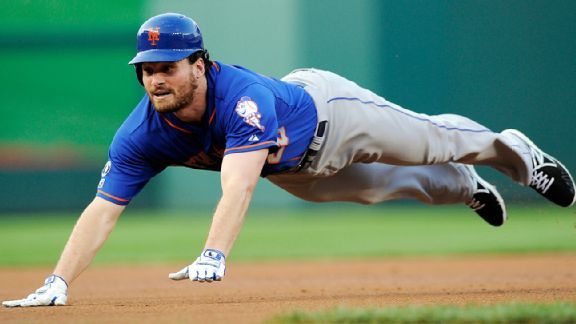 Nick Wass/Associated Press
Nick Wass/Associated PressAll-Star Daniel Murphy is projected to earn $8.1 million in 2015.

Pace Law School in White Plains won the sixth-annual Tulane National Baseball Arbitration Competition in 2013 in New Orleans. This week, Dan Masi (Pace ’14) and Jesse Kantor (Pace ’15) offer their salary projections for the Mets’ arbitration-eligible players, including detailed analyses for Lucas Duda, Dillon Gee, Jenrry Mejia and Daniel Murphy.
The Pace Law arbitration team is using the same methods agents and team officials employ.
On Day 2, here is an analysis of Murphy's projected 2015 salary.
Introduction
Second baseman Daniel Murphy is entering his third and final year of arbitration eligibility and will be eligible for free agency after the 2015 season.
Murphy had his best statistical season to date in 2013, which resulted in a salary of $5.7 million this past season. That marked a $2.775 million raise from the previous year. Even with stagnant -- or slightly depressed -- statistics this past season, Murphy’s 2014 numbers ranked impressively among other major league, and especially National League, second basemen. Murphy also was the Mets’ only 2014 All-Star selection.
Despite the presence of offensive and defensive deficiencies, Murphy remains one of the most consistent NL second basemen, and the Mets will have to pay him a salary commensurate with his production if they want him back in 2015.
The Case for the New York Mets
While the Mets will acknowledge and respect Murphy’s 2014 offensive contributions, they likely will argue his decreased production merits a smaller raise than he desires. Compared with 2013, Murphy scored 13 fewer runs, had 16 fewer hits, four fewer homers, 21 fewer RBIs, and 10 fewer stolen bases, while only increasing his batting average by three points.
Additionally, the Mets likely will argue that Murphy’s continued disappointing defensive statistics negate his hitting abilities. In 2014, Murphy had 15 errors, which was the most among 20 qualifying MLB second basemen. He also had a .974 defensive fielding percentage (FP), also the worst among 20 qualifying second basemen, and minus-10 defensive runs saved (DRS), which ranked third-worst among 20 qualifying second basemen.
The Case for Daniel Murphy
MURPHY RANKINGS
A look at where Daniel Murphy ranked in key statistical categories in 2014 among second basemen who had enough plate appearances to be qualifiers.
Murphy’s most impressive statistical category came in his .289 batting average, which was tied for the best among NL second basemen. His 37 doubles rank first among qualifying NL second basemen and fourth among all MLB second basemen. Murphy also placed in the top half of NL second basemen in plate appearances, runs, hits, stolen bases, on-base percentage, slugging percentage and on-base-plus-slugging percentage. These statistical rankings represent Murphy’s excellence as an NL second basemen and are certainly going provide Murphy’s representatives with a strong foundation for demanding a large salary increase.
Murphy’s case is further strengthened by being the Mets’ only All-Star selection as well as the team’s best hitter for most of last season. As the Mets’ 2014 leader in batting average, runs, hits, doubles, and stolen bases, it is evident how important Murphy is to the team’s success.
Comparable Players
MURPHY vs. GARDNER and LOWRIE
A statistical comparison for the platform seasons (year heading into third arbitration) and careers to that point of Daniel Murphy, Brett Gardner and Jed Lowrie.
Brett Gardner -- 2013 -- Salary: $5.6M -- Raise from previous year: $2.75M
As Brett Gardner’s numbers in his platform season are very similar to Murphy’s, the $2.75 million raise Gardner received in the 2013-14 offseason serves as an excellent predictor of Murphy’s 2015 salary. Although a center fielder by trade, Murphy and Gardner will be lumped together because they play “up the middle,” with Gardner getting a slight bump because of the more challenging fielding position.
Murphy had more hits, doubles, homers, RBIs and a better batting average, while Gardner had more runs, significantly more stolen bases, and a higher on-base percentage, slugging percentage and on-base-plus-slugging percentage. Although batting statistics are more important, Murphy’s poor fielding compared to Gardner’s is worth noting. With only three errors, a .991 FP, and six DRS at an arguably more difficult position, Gardner has excelled as an elite defensive player while Murphy continues to disappoint.
When comparing the players’ career numbers through the platform season, it becomes clear how strong of a base stealer Gardner is. He accumulated 161 to Murphy’s 55. Despite his speed, Gardner had 310 fewer career hits, 105 fewer doubles, 25 fewer homers, 152 fewer RBIs, and a lower batting average, slugging-percentage and on-base-plus-slugging percentage.
It appears Gardner was awarded his 2014 salary largely for his base-stealing capabilities. Because Gardner had nearly twice as many stolen bases than Murphy and only one less home run in his platform season, in addition to Murphy’s higher starting salary, it is reasonable to predict that Murphy’s raise will be less than $2.75 million. Although Murphy will never be the base-stealer or defensive weapon Gardner is, he has proven himself the more reliable hitter over time. Accordingly, it is reasonable to expect Murphy’s 2015 salary to be significantly higher than $5.6 million, but it is highly unlikely he will receive a raise greater than $2.75 million.
Jed Lowrie -- 2013 -- Salary $5.25M -- Raise from previous year: $2.85M
Murphy and Jed Lowrie also had extremely comparable platform seasons, with Murphy’s superior base-stealing abilities offset by Lowrie’s homer and RBI production. The players produced nearly identical amounts of runs, hits, doubles, and similar batting averages and on-base percentages. However, Lowrie exhibited much stronger power-hitting numbers, with 75 RBIs, 15 homers, a .446 slugging percentage, and a .791 on-base-plus-slugging percentage.
Also similar to Murphy were Lowrie’s poor defensive statistics in his 2013 platform season. At shortstop, Lowrie had 16 errors, a .962 FP, and an abysmal -18 DRS -- lower than Murphy across the board.
Despite similar platform seasons, a career comparison demonstrates Murphy’s superior hitting abilities. However, a career comparison is not as indicative here as it is in other situations because Lowrie became third-time eligible despite only 1,969 career plate appearances, compared with Murphy’s 3,081. While Murphy may have proved himself the more reliable hitter over time, Lowrie appears to be more of a power-hitting threat in the long term.
With similar hitting and fielding statistics in their platform seasons, but with Lowrie having the slight edge because of his superior power, Murphy should expect a lower raise than Lowrie received. However, the long-term consistency of Murphy leads us to believe his total salary will be much higher.
Predicted Result
While Murphy is not a top-tier slugger, he is an elite hitter when compared with the rest of the Mets’ roster. As a second baseman, Murphy could generally make up for ordinary hitting abilities with great fielding. But Murphy remains a defensive liability. Although batting statistics bear more weight in salary-arbitration proceedings, Murphy’s poor fielding -- especially in the NL, where there is no designated hitter and players derive more value from their fielding skills -- makes it less likely he will receive a raise equal to Gardner’s. Whereas Lowrie’s power-hitting capabilities as an American Leaguer were enough to offset his defensive liabilities, Murphy will likely not be able to ameliorate the effects of his fielding.
Accordingly, we predict Daniel Murphy can expect a raise of $2.4 million and an overall salary of $8.1 million for the 2015 season.
